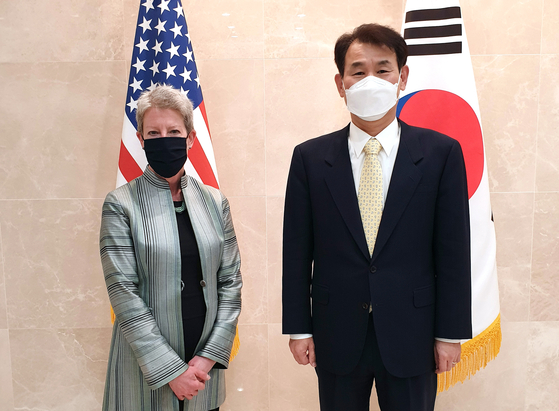![Ambassador Chung Eun-bo (right) and US representative Donna Wellton, who agreed to negotiate the ROK-US defense cost share in Washington DC on the 7th (local time). [사진 외교부]](https://i0.wp.com/pds.joins.com/news/component/htmlphoto_mmdata/202103/09/f01d76a8-a440-44d5-9780-7a877f717f8c.jpg?w=560&ssl=1)
Ambassador Chung Eun-bo (right) and US representative Donna Wellton, who agreed to negotiate the ROK-US defense cost share in Washington DC on the 7th (local time). [사진 외교부]
On the 7th (local time), South Korea and the United States concluded negotiations on the 11th Korea-US Special Agreement for Sharing Defense Costs (SMA), which had drifted for more than a year and a half in accordance with former President Donald Trump’s plan to increase significantly. It has been 46 days since the inauguration of the Joe Biden administration.
WSJ “Applied for 6 years to stabilize the alliance”
Undisclosed increase rate, 13% strong observation
It seems to be announced before the visit to Korea on the 17th of Blincoln
The Ministry of Foreign Affairs said in a press release on the day that “the negotiating representatives of the two countries reached a principle agreement with the 11th Korea-US SMA. We will continue to contribute to it.”
The US State Department also announced that “the ROK-US negotiating team agreed in principle on the new SMA text.” The State Department only responded to the JoongAng Ilbo’s inquiries about the agreement, saying, “The agreement includes a meaningful increase from Korea.”
The two countries did not specifically disclose key details, such as the rate of increase in contributions or the validity period of the agreement. On the 8th (local time), Ambassador Chung Eun-bo told Yonhap News, “We agreed, but please understand that we have agreed with the US that we will never comment on specific details before the completion of the internal procedure.”
In this regard, the Wall Street Journal (WSJ) cited diplomatic sources, saying that the new agreement will apply for six years, from 2020 to 25. The six-year validity period, the WSJ reported, is intended to provide a means to stabilize the alliance in a situation where the ROK and the United States face North Korea’s nuclear and missile programs and the threat of China’s military buildup.
Regarding the increase rate, there are observations that the ‘13% increase plan’ of the 2019 contribution (1.389 trillion won), which was agreed on in March last year but not approved by former President Trump, is influential. If applied retrospectively, the contribution in 2020 is KRW 1,173.9 trillion, but Foreign Minister Eui-Yong Chung said at the Foreign Communications Commission in February, “2020 is the same as the previous year’s level.” In this case, KRW 1,173.9 billion becomes a contribution in 2021.
Ambassador Jung said that the details of the agreement are likely to be announced before the’Korea-U.S. diplomatic and defense (2+2) talks’ held by Secretary of State Tony Blincoln and Defense Minister Lloyd Austin on the 17th.
A government source familiar with the relevant circumstances pointed out that “if the increase rate was agreed to 13%, Korea suffers a lot of losses compared to the past,” and “paradoxically, Biden enjoys the effect of Trump’s pressure”. In fact, this is the first double-digit increase since 2005.
Washington = correspondent Park Hyun-young, Seoul = reporter Park Hyun-joo [email protected]
![]()
